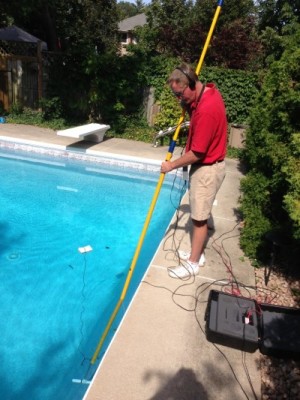Pool Leak Detection

Electronic Pool Leak Detection
For many pool owners this day does eventually arrive and we are called in a panic. The key to finding leaks is to follow a systematic approach that will isolate the problem. The first steps can be easily handled by the pool owner, thus minimizing the time and cost involved. Prior to the steps outlined below, you should perform a visual inspection to check for any obvious leaks due to liner damage, leaking equipment, or wet spots in the ground.
At this point, it is important to determine if the pool is actually leaking or whether the water loss is due to normal loss from evaporation or splashing. It is also helpful to establish just how much water the pool is losing. To determine whether or not the pool is leaking, follow these steps:
The Bucket Test
- Fill the pool to it’s normal level
- Fill a bucket with water to 3/4 level
- Place the bucket in the pool (on stairs if possible or tie to a ladder).
- Mark the level in the pool and the bucket.
- 24 hours later, check the level in the pool and the bucket. If they have both gone down at the same rate there is no water loss. If the pool water has dropped more than in the bucket, there is water loss.
To Determine The Amount Of Loss
Measure the difference in loss between the pool and the bucket in inches, then use the following formula:
- Water loss in inches X .62 X square ft of pool surface = loss in gallons. (1 Gallon = 3.78541 Litres)
Now that you’ve determined that the pool is leaking, the next step is to determine whether the water loss is from the “shell” (liner, stairs, plumbing interfaces etc) or in the piping.
To Determine The Source Of Water Loss
- Fill the pool to its normal operating level and mark the level with a piece of tape.
- Turn the system off and remove the jets.
- Install the winterizing plugs in the jets and the skimmer.
- Check the water level after 24hrs. If the water level has not dropped at all (with the exception of the evaporation as determined in the previous step) the leak is in the piping. If the water level has continued to drop then the leak is in the shell.
At this point you will need to contact us to discuss the options.
We utilize a variety of methods to locate leaks including pressure testing, sonar detection, and diving. In most cases we can isolate a leak to a very small area. The costs for repairing leaks can vary depending on numerous factors including ease of access to the leak (i.e. must we cut concrete, are there obstacles in the way, etc.) and the nature of the leak. In the case of vinyl liners, the age of the liner can be a factor as well. A technician will be happy to discuss all these factors with you.
A technician will be happy to discuss all these factors with you.
To Determine The Average Pool Depth
- Depth of Deep End (metres) + Depth of Shallow End (metres) divided by 2 = Average Depth of Pool (metres)
To Determine The Capacity Of Your Pool Shape
- Square or Rectangle: Length x Width x Average Depth x 1,000 Litres
- Oval: Long Diameter x Short Diameter x Average Depth x 787 Litres
- Circular: Diameter x Diameter x Average Depth x 787 Litres




